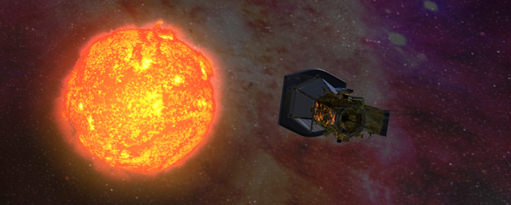[/caption]
NASA recently announced its choices for the experiments to fly aboard the Solar Probe Plus spacecraft, which is slated to launch no later than 2018. This spacecraft will perform the unprecedented task of flying into the Sun’s atmosphere – or corona – to take measurements of the plasma, magnetic fields and dust that surround our nearest star. It will be the first human-made satellite to approach the Sun at such a close proximity.
The previous record-holder for a spacecraft that approached the Sun was Helios 2, which came within 27 million miles (43.5 million kilometers) of the Sun in 1976. Solar Probe Plus will shatter that record, flying to 3.7 million miles (5.9 million kilometers) of the Sun’s surface at its closest approach. In flying so close to the Sun, the spacecraft will be able to get amazingly detailed data on the structure of the atmosphere that surrounds the Sun.
As you can imagine, it gets a little toasty as one gets that close to the Sun. Solar Probe Plus will utilize a special heat shield made of an 8-foot (2.4 m), 4.5 inch (11 cm)-thick special carbon-composite foam plate that will protect the craft from temperatures of up to 2600 degrees Fahrenheit (1400 degrees Celsius) and intense solar radiation. The heat shield is a modified version of that which was used in the MESSENGER mission to Mercury.
NASA has chosen five science projects out of the thirteen that were proposed since 2009. The selected proposals are, according to the press release:
— Solar Wind Electrons Alphas and Protons Investigation: principal investigator, Justin C. Kasper, Smithsonian Astrophysical Observatory in Cambridge, Mass. This investigation will specifically count the most abundant particles in the solar wind — electrons, protons and helium ions — and measure their properties. The investigation also is designed to catch some of the particles in a special cup for direct analysis.
— Wide-field Imager: principal investigator, Russell Howard, Naval Research Laboratory in Washington. This telescope will make 3-D images of the sun’s corona, or atmosphere. The experiment actually will see the solar wind and provide 3-D images of clouds and shocks as they approach and pass the spacecraft. This investigation complements instruments on the spacecraft providing direct measurements by imaging the plasma the other instruments sample.
— Fields Experiment: principal investigator, Stuart Bale, University of California Space Sciences Laboratory in Berkeley, Calif. This investigation will make direct measurements of electric and magnetic fields, radio emissions, and shock waves that course through the sun’s atmospheric plasma. The experiment also serves as a giant dust detector, registering voltage signatures when specks of space dust hit the spacecraft’s antenna.
— Integrated Science Investigation of the Sun:principal investigator, David McComas of the Southwest Research Institute in San Antonio. This investigation consists of two instruments that will take an inventory of elements in the sun’s atmosphere using a mass spectrometer to weigh and sort ions in the vicinity of the spacecraft.
— Heliospheric Origins with Solar Probe Plus: principal investigator, Marco Velli of NASA’s Jet Propulsion Laboratory in Pasadena, Calif. Velli is the mission’s observatory scientist, responsible for serving as a senior scientist on the science working group. He will provide an independent assessment of scientific performance and act as a community advocate for the mission.
Two important questions that the mission hopes to answer is the perplexing mystery of why the Sun’s atmosphere is hotter than its surface, and the mechanism for the solar wind that emanates from the Sun into the Solar System. The spacecraft will have a front-row seat to watch the solar wind speed up from subsonic to supersonic speed.
Because of the conservation of momentum, it takes a lot of slowing down to send a spacecraft towards the Sun. The Earth and objects on the Earth are traveling around the Sun at an average of 30 kilometers per second (67,000 miles per hour). So, to slow the spacecraft down enough to get it close to the Sun, it will have to fly around Venus seven times! This is the opposite of a gravity assist, or “slingshot”, in which a satellite gains energy by flying by a planet. In the case of Solar Probe Plus, as well as that of MESSENGER, multiple flybys of Venus imparts some of the craft’s energy to Venus, thereby slowing down the spacecraft.
The Solar Probe Plus mission is part of NASA’s “Living With a Star Program”, of which the Solar Dynamics Observatory is also a mission. This program is designed to study the impact our Sun has on the space environment of the Solar System, and acquire data to better equip future space missions.
Source: NASA press release, APL mission site

